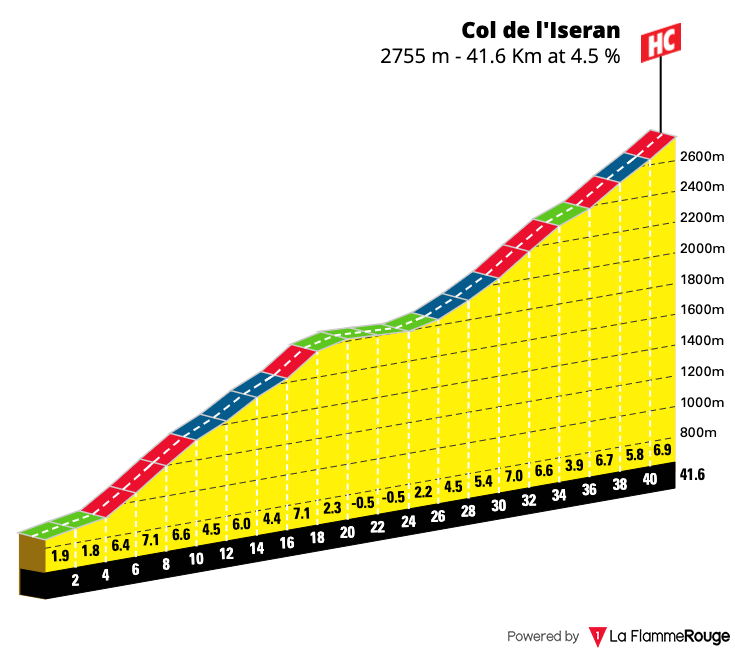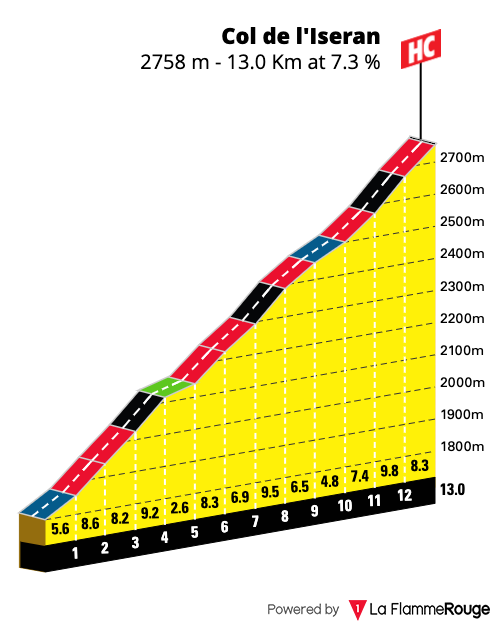A Guide to Cycling the Col de l’Iseran
This ride to the summit of the Col de l’Iseran leads you to the top of Europe’s highest paved pass from the southern approach. At 2770m / 9087ft you are certainly in for a big day of climbing. Due to its location, we recommend catching the train to the starting point of Modane. From Saint Jean de Maurienne the train trip will take approximately one hour. From here you will have a 25km ride up the valley to Lanslebourg before you begin the ‘official’ start of the climb. If you have access to a car you can of course skip this section of the ride altogether and choose instead to start at Lanslebourg.
A climb with Tour de France Pedigree
The Col de l’Iseran has featured in the Tour de France eight times, first making its appearance in the race in 1938. Famously in 2019, it was the top of the Col de l’Iseran which was chosen as the stage finish after a freak hailstorm cut the stage short. Here Egan Bernal crested the summit first and famously went on to wear the yellow jersey as the victor in Paris.
Ready yourself for a challenging climb
It isn’t just the maximum elevation or the length which makes cycling the Col de l’Iseran challenging. You will also encounter gradients well into double digits, which will strain the legs. Once reaching the summit you will be greeted by a solitary chapel and a small gift shop/cafe. A good spot to take some time to look at the mountains which surround you.
Quick Stats
Distance: 114.7km / mi
Start elevation: 1059m / 4203ft
Max elevation: 2770m / 9060ft
Metres climbed: 2424m / 4702ft
Metres descended: 2424m / 4702ft
Categorised climbs: 1
Food and water
When Cycling the Col de L’iseran be prepared for a long and challenging ride. We definitely recommend you set off with plenty of food and water. You can refuel at both Lanslebourg and Bonneval Sur Arc, as well as at the small cafe at the top of the pass itself.
Don’t underestimate the toll the elevation can take on you as you make your way up to the summit and be sure to keep on top of your nutrition.
Highlights
- Reaching the top of Europe’s highest paved pass – and second highest alpine pass.
Col de l’Iseran climb statistics and gradient profile

Col de l’Iseran
Length: 29.4km / 18.3mi
Average gradient: 5.2%
Start point: Lanslebourg
Elevation at top: 2770m / 9060ft

Everything you need to know before cycling the Col d’Iseran
How long does it take to cycle the climb?
Generally speaking, it will take a well-trained cyclist anywhere from 1hr 45 min to 2.5hrs to cycle the Col d’Iseran climb. This is a long climb and the combination of the length, as well as elevation, will make cycling the Col d’Iseran a challenge.
How steep is the gradient of the climb?
The average gradient on the Col d’Iseran climb is 5.2% and the steepest gradient is 12%.
Can a beginner cycle the Col d’Iseran?
While it is obviously possible for a beginner to cycle the Col d’Iseran, this is not a climb we would recommend for those new to cycling. The climb is very long and this combined with the elevation height will take its toll on a beginner. Hiring an e-bike to ride the climb is possible, however, be mindful to conserve the battery on such a long climb.
How hard is the climb?
The Col d’Iseran is a very challenging climb both in length as well as gradient. It is categorized as an Hors Category climb which is the most difficult.
What is the height at the summit?
The Col d’Iseran sits at an elevation of 2770m / 9060ft making it Europe’s highest paved road pass.
Where is the climb located?
The Col d’Iseran is located in the Savoie department in the French Alps.
When is the best time of year to ride the climb?
If you plan to cycle the Col d’Iseran we would recommend doing so in July or August. Due to its elevation and the winter snow, the road to the summit is only able to be ridden between June to September each year. The exact dates the road is open change each year depending on the amount of snow from the winter season which requires to be cleared.
How many times has the climb been used in the Tour de France
The Col d’Iseran has featured in the Tour de France on 8 occasions and was first included in the 1938 edition of the race.
How do I get to the climb?
There are limited public transport links to the base of the climb of the Col d’Iseran. We would recommend catching a train from St Jean de Maurienne to Modane which is located 25kms from the base of the climb.
What is at the top of summit?
There is a small cafe located at the summit of the Col d’Iseran where you will be able to resupply with food and water.
Where is the Closest bike rental to the climb?
You can hire a bike to ride the Col d’Iseran from St Jean de Maurienne.
Where is the best place to base yourself to ride the climb?
We would recommend basing yourself in one of the villages along the Maurienne and Isere Valleys in order to ride the climb of the Col d’Iseran.
Discover our comprehensive guide to Cycling in the French Alps
Cycling the Col de l’Iseran climb is just one of many great riding routes in the French Alps.
If you are not familiar with the cycling available in the French Alps then, our comprehensive guide will help you plan everything you need for your cycling holiday. The guide includes information such as:
- a map of the French Alps with climbs and towns marked
- where to base yourself whist on your cycling holiday
- cycling hotels and lodges
- bike hire outlets
- getting to and from the French Alps
- non-cycling attractions and activities in the region
Click here to see a list of cycling routes available in the French Alps.
